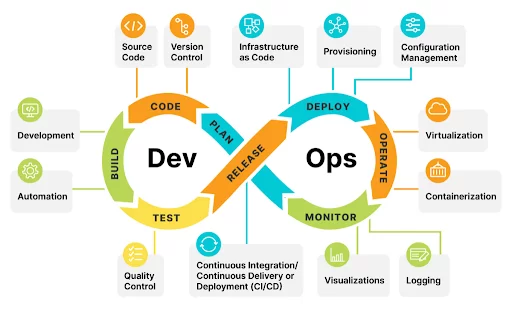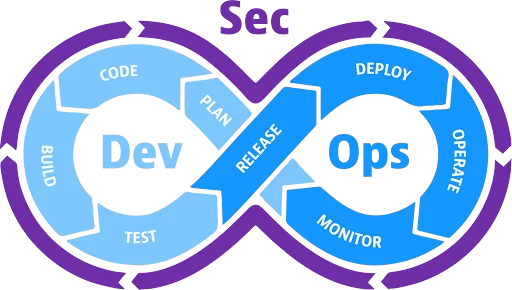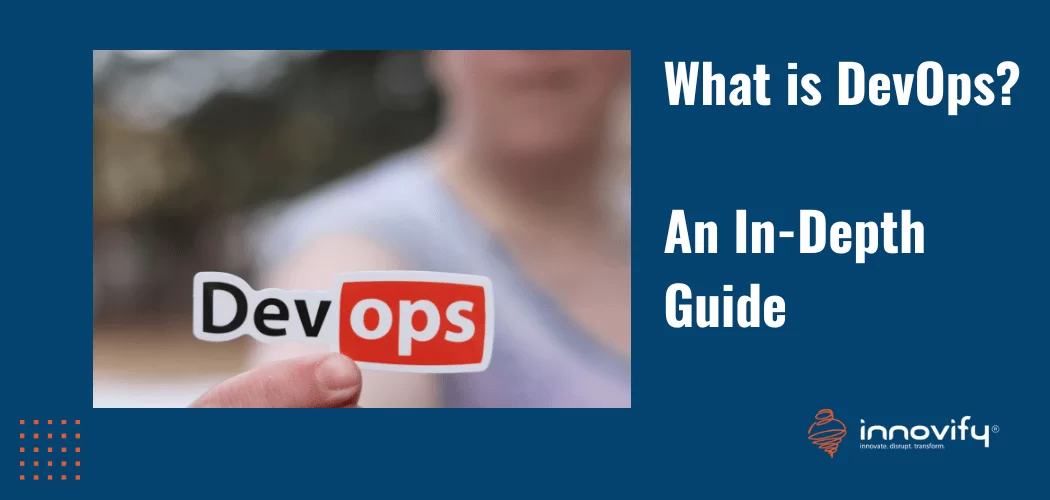AI/ML
What is DevOps – An In-Depth Guide to the working procedure of devops methodology
With a 21% adoption rate, DevOps is the top software development methodology worldwide. But why this hype? What is DevOps? And how does it change the conventional software development process?
We’ll discuss everything you should know about DevOps in this article.
So, without further ado, let’s get started.
What is DevOps and How it Works?
DevOps combines two terms – ‘development’ and ‘operations.’ It represents a collaborative and shared approach to developing software applications. A typical DevOps development process includes planning, coding, building, testing, releasing, deploying, operating, and monitoring.

Organizations using traditional software development and infrastructure management processes are slower at innovating and improving their products.
DevOps combines cultural philosophies, practices, and tools. As a result, an organization that uses DevOps to develop and maintain software and infrastructure can deliver products and services at a fast pace, making them more Agile.
DevOps processes, including the necessary infrastructure and tools for building, testing, and deployment, can now be accessed via the cloud as a service, effectively transforming DevOps into a comprehensive cloud-based solution. This shift has led to the emergence of the term “DevOps as a service.”
What is the working procedure of DevOps methodology?
DevOps works by breaking down the traditional silos between development and operations teams and creating a culture of continuous integration and deployment.
In a DevOps environment, developers and operations teams work together to automate the software development process, from code development to testing and deployment. Continuous integration and continuous deployment (CI/CD) pipelines are used to automate the building, testing, and deployment of software applications, allowing for faster release cycles and more frequent updates.
Working procedure of DevOps methodology also involves monitoring and feedback loops, where teams can monitor application performance and user feedback to continuously improve the software. Overall, DevOps aims to increase collaboration, efficiency, and quality in software development and delivery.
6 Benefits of DevOps for Modern IT Teams
Common problems for technology teams include releases that take too long, software that doesn’t live up to expectations, and IT that hinders corporate expansion.
6 Benefits of Devops for High Quality Software:
1. Rapid Delivery
With DevOps, you can innovate and improve your product faster by releasing new features and fixing bugs more frequently and quickly. By releasing new features and fixing bugs more rapidly, you can respond to your customers’ needs and gain a competitive advantage quicker. Continuous integration and continuous delivery are the DevOps practices that automate the software release process, from build to deployment.
2. Speedy Updates
The DevOps methodology enables you to innovate for clients faster, adapt to changing markets better, and become more efficient at driving business results. It is done by combining developers and operations personnel. For instance, microservices and continuous delivery allow groups to take charge of services and then release updates to them faster.
3. Software Reliability
With DevOps in place, you can monitor and log application updates and infrastructure changes to ensure that you can reliably deliver at a faster pace while maintaining a positive user experience. Developers can use continuous integration and continuous delivery to ensure that each change is functional and safe. In real-time, monitor and log performance to stay informed.
4. Scalability
DevOps enables IT teams to scale their infrastructure and development procedures by automating and ensuring consistency. With automation and consistency, you may efficiently manage complex or shifting systems with less danger. For example, you may use infrastructure as code to manage your testing, production, and development environments more consistently and efficiently.
5. Improved Team Collaboration
With DevOps, you can build more effective teams by emphasizing values such as ownership and accountability. In a DevOps environment, developers and operations teams work closely together, share many responsibilities, and combine their workflows, all of which result in reduced inefficiencies and saved time.
6. Enhanced Security
Using automated compliance policies, configuration management techniques, and fine-grained controls, you can retain security control while iterating quickly. For example, in DevOps, you can define and track compliance at scale using infrastructure as code and policy as code.
How to Implement DevOps in an Existing IT Setup
DevOps transformations take time. Many enterprises begin with a pilot project – a simple application where they may get a feel for new methodologies and tools. For big DevOps adoption, they take steps gradually.
By leveraging AI in DevOps, IT teams can transform their software development approach from one characterized by infrequent releases and slow innovation cycles, to a faster and more efficient one that involves rapid iteration cycles. This is made possible through the use of continuous integration and continuous delivery (CI/CD) pipelines, as well as automated production monitoring, both of which are augmented by machine learning capabilities that enhance developer expertise.
The following two approaches are prevalent in terms of DevOps implementation:
1. DevOps Cultural Philosophy
There must be a culture and mindset change when going from a traditional development approach to DevOps. The two traditionally siloed teams, development and operations are connected with DevOps.
In some organizations, there may not even be separate development and operations teams; rather, engineers might perform both jobs. DevOps philosophy can be useful in such teams.
With DevOps, the two teams (or processes) collaborate to maximize both development and operational efficiency. DevOps teams seek to improve communication, efficiency, and quality of services they provide to customers by frequently communicating, reducing costs, and increasing quality.
The DevOps model prioritizes collaboration, inclusion, and ownership, enabling development and operations teams to take charge of responsibilities that go beyond their stated roles or titles by considering the customer’s needs and how they might address them.
Quality assurance and security professionals might also be closely involved with these teams. Regardless of their organizational structure, IT teams using DevOps consider the entire development and infrastructure lifecycle as part of their responsibilities.
2. Implementation via DevOps Practices
Organizations can improve their innovation ability by automating and simplifying the software development and infrastructure management processes via DevOps practices.
7 DevOps Best Practices:
Continuous Integration
Continuous integration is a technique in which developers integrate their code changes into a central repository, and automated builds and tests are subsequently executed. Continuous integration aims to reduce the time it takes to verify and release new software updates by finding and eliminating bugs faster, improving software quality, and increasing software quality.
Continuous Delivery
Continuous delivery is a method of delivering software in which all updates are automatically built, tested, and prepared for release. It builds upon continuous integration by delivering all code modifications to a testing environment or a production environment after the build phase.
When implemented properly, continuous delivery provides developers with deployment-ready build artifacts that have been through a standardized testing procedure.
Microservices
Microservice architecture is a design approach for constructing a single application out of numerous tiny services. Each microservice runs in its process and communicates with the others via a lightweight protocol, such as an HTTP-based application programming interface (API).
Microservices are built around business functions; each is focused on a single objective. Therefore, you can utilize different development frameworks or languages to develop microservices and deploy them individually, in groups, or as a single entity.
Infrastructure as a Code (IaaC)
IaaC is a technique in which application infrastructure is provisioned and managed using code and development practices such as continuous integration and version control.
Infrastructure can be interacted with using the cloud’s API in a program rather than manually set up and configured, allowing developers and system administrators to scale. Infrastructure in a DevOps setup can be accessed using code-based tools and treated in a similar way as application code because engineers can use code to interface with infrastructure.
Infrastructure and servers can be deployed quickly using standard patterns, updated with the latest patches and versions, and duplicated in repeatable ways.
Configuration Management
Operating systems and hosts can be configured using code, which makes for standardized and repeatable configuration. Developers and system administrators typically automate operational tasks or use code to configure operating systems, system applications, or server software. Using code liberates them from having to manually configure.
Monitoring and Logging
Organizations capture, categorize and analyze data and logs generated by applications and infrastructure to determine how their performance affects customer satisfaction.
By examining the data and logs, organizations can determine how changes or updates affect users and identify their underlying causes, providing a better understanding of problems or unexpected changes.
Since services must be available 24/7, applications and infrastructure are updated more frequently, and active monitoring becomes increasingly important. By creating alerts or conducting real-time analysis of this data, organizations are better able to monitor their services.
Communication and Collaboration
DevOps improves collaboration and communication across an organization. Its tooling and automated software delivery help teams work together. DevOps methodology uses chat applications, issue trackers, and wikis to mediate communication, bringing together the development and operation teams’ workflows and responsibilities.
Working together, these teams establish strong norms about sharing information and facilitating communication through chat applications, issue trackers, and wikis, which allows all parts of the company to better align on objectives and initiatives.
When it comes to DevOps, it’s essential to consider security as an integral part of the software development process. Modern DevOps teams prioritize security by incorporating it into every stage of the development cycle. This includes implementing best practices such as code analysis, vulnerability testing, and regular security audits. This is where DevSecOps comes into place.
What is DevSecOps?
DevSecOps, aka DevOps security, refers to safeguarding the entire DevOps environment through strategies, processes, policies, and technologies. DevSecOps philosophy states that security should be integrated into every stage of the DevOps life cycle, from inception to design, build, testing, release, support, maintenance, and beyond.

Traditionally, security strategies occur too late in the development process and often slow the design and release of the software. In such scenarios, security defects are identified and remedied before the system’s final release. When applied to DevOps, the traditional security approach creates a major barrier to releasing applications and services quickly.
On the other hand, everyone in a DevSecOps team focuses on implementing security decisions at speed and scale without sacrificing safety. Release engineers and security teams collaborate on DevSecOps to deliver secure code quickly and at scale.
The process of delivering secure code is streamlined by combining “speed of delivery” and “building secure code” into one process. Security testing takes place in phases without slowing down delivery cycles. Security issues are addressed as they become apparent, not after a threat or breach has occurred.
7 DevOps Tools for Implementation
Of course, as experts argue, DevOps is a mindset, not a set of tools. But in order to implement it, an organization would require tools.
As DevOps methodology has been around for a while now, there are a plethora of DevOps tools available for IT teams. Following are the top ones:
Database Tools
Version Control Tools
Container Management Tools
Deployment and Server Monitoring Tools
Configuration Management Tools
CI / Deployment Automation tools
Should You Adopt DevOps?
Because DevOps methodologies are considered the best practice for software development, the majority of Fortune 500 enterprise corporations have already adopted them. The biggest IT firms are driving the DevOps movement because they want to optimize public cloud operations as DevOps and cloud computing are key enablers for enterprise digital transformation.
In the cutthroat software market, every company wants to save money and increase efficiency when developing and producing software, and DevOps helps them achieve that.
In addition, DevOps methodologies are being used by many startups to gain a competitive advantage or disrupt existing markets.
If you fall into any of these scenarios, DevOps is the best option for you.
Frequently Asked Questions (FAQs)
1. What is a common misconception about Agile and DevOps?
A common misconception is that Agile and DevOps are the same things. While Agile is a software development methodology that focuses on delivering value through iterative development and customer collaboration, DevOps is a set of practices that automate the software delivery process and improve collaboration between development and operations teams.
2. What is one key purpose of DevOps?
One key purpose of DevOps is to provide continuous delivery of high-quality software to customers. By automating the entire software delivery process, DevOps ensures that software is delivered faster, more reliably, and with fewer errors.
3. What two practices is DevOps bringing together?
DevOps is bringing together software development (Dev) and IT operations (Ops), to ensure that software is developed, tested, deployed, and maintained quickly and efficiently.
4. What is continuous delivery in DevOps?
Continuous delivery is a key practice in DevOps that involves automating the entire software delivery process, from building to deployment, testing, and monitoring. Continuous delivery ensures that software is delivered quickly, reliably, and with high quality.




